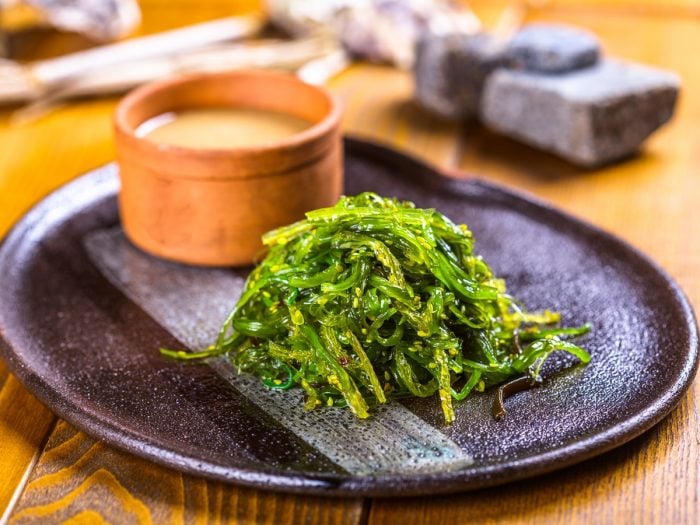Iodine is an essential mineral that plays a key role in the synthesis of thyroid hormones. Without this element, the thyroid gland is unable to produce enough hormones, which may lead to various health conditions like goiter, hypothyroidism, and hyperthyroidism. Research shows that globally, almost 2 billion people suffer from iodine deficiency. Although iodine is naturally found in many foods, many of us do not consume enough of it. In this article, let us take a look at the most common iodine-rich foods. [1]
Iodine-Rich Foods
Experts recommend at least 150 micrograms of iodine per day for healthy adults. This may be higher or lower depending on your specific medical conditions, or if you are pregnant or breastfeeding. So, you can include the following foods in your diet and possibly prevent iodine deficiency. [2] [3]

Seaweed is one of the best iodine-rich foods. Photo Credit: Shutterstock
Seaweed
Seaweed is by far one of the best sources of iodine-rich foods. One sheet i.e. one gram of seaweed contains up to 2984 mcg iodine.
Kombu is an edible kelp that is generally used to make dashi, a Japanese soup stock. According to a 2014 study, kombu contains about 2523.5 mg/kg of iodine, which is more than that of wakame and nori. [4]
Wakame is a brown seaweed that is mostly used in miso soup. It is found to have about 139.7mg/kg of iodine.
Nori is a red seaweed and is typically used in sushi. In comparison to other seaweed, nori contains very less iodine (36.9mg/kg).
You can add seaweed in your sushi, salads, or make a snack out of it.
Please note that iodine content varies in seaweed as the iodine concentrations keep changing across the world. [5]
Fish
Fish like tuna and cod are rich in iodine.
3 ounces of tuna, canned in oil and drained, provides you with 17 mcg of iodine. Tuna is also rich in potassium, magnesium, and selenium, along with beneficial fatty acids that can protect heart health. [6]
3 ounces of baked cod fish contains about 99 mcg of this nutrient. That is more than 65% of your daily requirement of this nutrient, and cod also has high levels of beneficial omega-3 fatty acids. [7] [8]
You can add these fish in many dishes like curries, stews, and tacos.
Shrimp
Shrimp absorbs iodine that is naturally present in the seawater. This makes it a good option for an iodine-rich food.
When it comes to daily value, 3 ounces of shrimp contains about 35 mcg of iodine (23% of recommended intake). [9]
Here is an easy Avocado Shrimp Salad With Zesty Dressing.
Dairy
Milk, yogurt, and cheese are a good way to consume iodine if you are a vegetarian.
A cup of milk, after reducing fat, contains 55 mcg of iodine. You can have it in your chai or coffee.
One ounce of cheddar cheese offers about 12 mcg of iodine. However, different types of cheese have different amounts of iodine. Check the label while buying. Furthermore, cheese is quite high in calories, so do watch the quantity. [10]
Yogurt is another great dairy option to pair your granola with. It has more than 150 mcg per cup. That means that you can satisfy your entire daily requirement of iodine by the end of breakfast!
Poultry
Eggs are a rich source of protein, vitamin E, vitamin A, and various antioxidants. [11]
A boiled egg also delivers about 12 micrograms of iodine, nearly 10% of what your body needs every day. So go ahead and add it to your breakfast, lunch, or dinner and get that required boost!
Iodized Salt
A little salt is good for your palate, as well as your health.
One-quarter of a teaspoon of salt contains about 71 mcg of iodine. Add it to your cooking in a moderate amount. Also, for people with high blood pressure, do consult with your doctor before increasing the quantity.
For more information on iodized salt, read this detailed article.
Vegetables
Very few vegetables contain notable amounts of iodine.
Some include potatoes, green leafy vegetables, and onions. Potatoes were considered as a source of iodine during World War II. [12]
You can add vegetables to your meat-based recipes to have a balanced meal.
Fruits
Fruits like prunes and berries contain iodine.
10 dried prunes contain about 26 mcg of iodine, which is about 18% of the daily requirement. The level of fiber, potassium, iron, and vitamin K further makes this an all-around healthy food option. [13]
Cranberries contain 400 micrograms of iodine in only four ounces. That equates to more than 250% of your daily recommended intake. [14]
However, this concentration of iodine may not be available in all places as the element is not distributed equally around the world.
Beans
For those who love having beans, these foods are a decent source of iodine.
One cup of navy beans delivers 64 mcg of this element, which is more than 40% of your daily requirement. This is in addition to dietary fiber and various key minerals the body needs. [15]
Corn
A single cup of corn will deliver 28 mcg of iodine, which is about 20% of what your body requires.
It is in addition to good amounts of fiber, B vitamins, and protein that corn offers. [16]
Other Sources of Iodine
Apart from the ones mentioned above, a few other foods that contain iodine are as follows:
- One enriched white bread: 22.5 mcg
- One cup of raisin bran cereal: 11 mcg
- One cup of apple juice: 7 mcg
- Half cup of frozen and boiled green peas: 3 mcg
- A medium banana: 3 mcg
As common and harmful as iodine deficiency is, overconsumption of iodine is also a threat to human health. We suggest you watch your dietary habits and consume it in moderation to stay on a healthier side. [17] [18]
